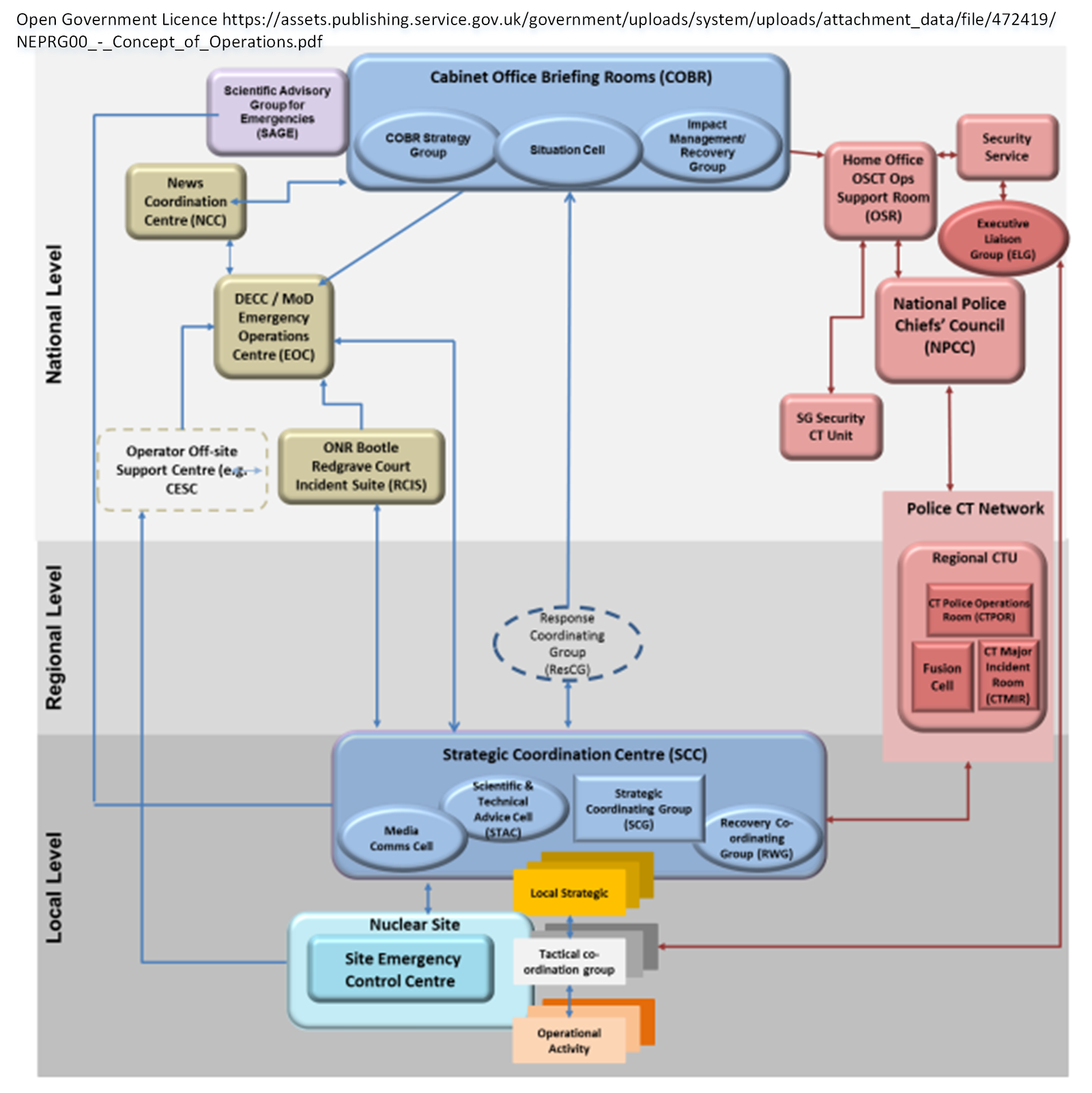UK Concept of Operations (Nuclear emergency planning)
Introduction
An outline of the UK’s nuclear emergency planning from the view point of central government is given in the 2015 document Con-ops
Nuclear Emergency Planning and Response Guidance, Concept of operations

A large number of people will be involved in the response to and recovery from a radiation emergency.
Operational There will be "boots on the ground", emergency services and other people working to rescue casualties, put out fires, recover or immobilise dangerous materials, control access and egress from the scene and reporting the situation and resource needs. These are the operational or bronze responders. Each service will have their own command structure on site with well practiced coordination. (See JESIP website if interested in response coordination).
Tactical A layer of command will be determining how best to use the available resource to meet the objectives set. These are the tactical or silver level. The different responding organisations will attempt to put their tactical commanders in the same place so that they can co-operate and co-ordinate.
Strategic The top layer of local command is the strategic or gold layer. A strategic commander from each agency has overall authority on behalf of their agency. They are responsible for the resources of their own agency and for formulating their single agency strategy for the incident. They generally meet in the SCC to exchange situational awareness, agree priorities and provide resource and expertise. The strategic level, which includes a wider range of government bodies, regulators and experts also discuss the protection of the public including agreeing the protective action strategy and the media management strategy and media messages.
Supporting the local structures, if required, are a range of national and regional facilities reaching up to the Cabinet Office Briefing Rooms.
The structure is designed to “grow upwards” if the situation demands it. A smaller event (if you can have a “small” nuclear emergency) may only need the local components. There is, however, an apparent ambiguity in some of the relationships. The connectors are not carefully defined so could be taken to be “chats to”. More clarity could be achieved by differentiating between information flow and instruction and how this may change with time and severity. Generally, information and requests for resource go upwards and instructions and advice go downwards from command and technical structures respectively.
The UK Nuclear Emergency Planning and Response Guidance Concept of Operations (Con-ops) document identifies the core characteristics of an effective response as:
- Anticipation: Risk assessment and risk communication.
- Preparedness: Clarity of roles and responsibilities, supported by training, exercising and the availability of equipment and agreed procedures.
- Continuity: It is helpful if individuals and teams are asked to carry out similar roles, using the same tools as they employ in their normal work rather than expect them to do something very different or use unfamiliar systems with occasional training.
- Subsidiarity: Decisions should be taken at the lowest appropriate level, with co-ordination at the highest necessary level.
- Direction: Clarity of purpose should be delivered through a common awareness of the strategic aims and supporting objectives for the response agreed at the Strategic Co-ordinating Group (SCG).
- Integration: Effective co-ordination should be exercised between and within organisations both at the local and national levels of a response. For the emergency services this is second nature based on the JESIP principles.
- Communication: Good two-way communications are critical to an effective response. This is both about physical communications technologies and about situational awareness and shared understanding.
- Co-operation: Positive engagement based on mutual trust and understanding will facilitate information-sharing and deliver effective solutions to arising issues.